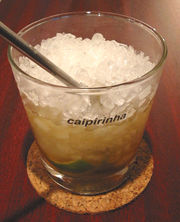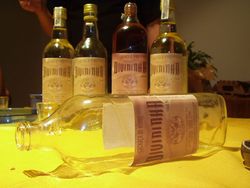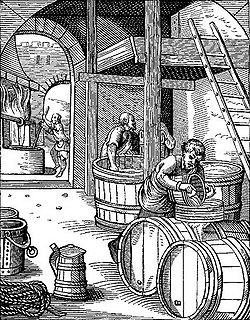Cachaça

Cachaça (Portuguese pronunciation: [kaˈʃasɐ]) is a liquor made from fermented sugarcane. It is the most popular distilled alcoholic beverage in Brazil. It is also known as aguardente (aguardiente), pinga, caninha or other names. Cachaça is mostly produced in Brazil, where, according to 2007 figures, 1.5 billion liters (390 million gallons) are consumed annually, compared with 15 million liters (4.0 million gallons) outside the country.[1] It is typically between 38% and 54% alcohol by volume.[2]. When it is homemade it can be as strong as the distiller wants. Up to six grams per liter of sugar may be added."[3] The major difference between cachaça and rum is that rum is usually made from molasses, a by-product from refineries that boil the cane juice to extract as much sugar crystals as possible. And cachaça is made from fresh sugarcane juice that's fermented and distilled.[4]
Figures from 2003 indicate 1.3 billion liters of cachaça are produced each year though only 1% of this production is exported (mainly to Germany).[5] Outside Brazil, cachaça is used almost exclusively as an ingredient in tropical drinks, with the caipirinha being the most famous cocktail.
Contents |
Production

There are two types of cachaça: artisanal and industrial.
Artesanal cachaças are produced by thousands of small mills spread all over the country. Traditionally, the fermentation agent is maize flour (called fubá in Portuguese) and the distillation unit is a copper pot still. The resulting product comes out in three phases: "heads", "hearts" and "tails". Most of the makers take only the "hearts", discarding (or re-distilling) the other two which have undesirable components. Then the beverage is either bottled or stored in wood barrels for aging. The cachaça is aged in barrels made from a great variety of native or exotic trees such as chestnut, umburana, jequitibá, ipê, grápia, balsam wood, almond, jatobá, guanandi, brazilwood, cabreúva, tibiriçá, garapeira, cherry, and oak.[6]
Cachaça, like rum, has two varieties: unaged (white) and aged (gold). White cachaça is usually bottled immediately after distillation and tends to be cheaper (some producers age it for up to 12 months wooden barrels to achieve a smoother blend). It is often used to prepare caipirinha and other beverages in which cachaça is an ingredient. Dark cachaça, usually seen as the "premium" variety, is aged in wood barrels and is meant to be drunk straight (it is usually aged for up to 3 years though some "ultra premium" cachaças have been aged for up to 15 years). Its flavor is influenced by the type of wood from which the barrel is made.[7]
See also
- List of brands of Cachaça
- Caipirinha
- Cocktails with cachaça
- List of cocktails with cachaça
- List of Brazilian dishes
References and notes
- ↑ Carter, Kelly E. (2007-02-16). "Cachaça: It's the essence of Brazil in a bottle". USA Today (Gannett Company). http://www.usatoday.com/travel/destinations/2007-02-15-brazil-cachaca_x.htm. Retrieved 2008-02-21.
- ↑ www.unesp.br/aci/jornal/147/cachaca.htm
- ↑ "Resposta técnica - cachaça" (pdf). http://sbrt.ibict.br/upload/sbrt1887.pdf. Retrieved 2007-02-18.
- ↑ http://www.cocktailtimes.com/dictionary/cachacas.shtml
- ↑ "Marvada chique". Editora Globo. 2003-05. http://revistagloborural.globo.com/EditoraGlobo/componentes/article/edg_article_print/1,3916,533013-1641-1,00.html. Retrieved 2007-02-18.
- ↑ Discovering Cachaça
- ↑ Kugel, Seth. "Allure of Cachaça Spreads to U.S. From Brazil". The New York Times, April 9, 2008. Accessed 1 June 2009.
External links
- State of Paraty Tourism Website—Information in Portuguese on cachaça production
- O Álbum Virtual de Rótulos de Garrafas de Cachaça na Net—Web site dedicated to cachaça labels. In English and Portuguese.
|
|||||||||||||||||||||||||||||||||||||||||||||||||||||||||||||


